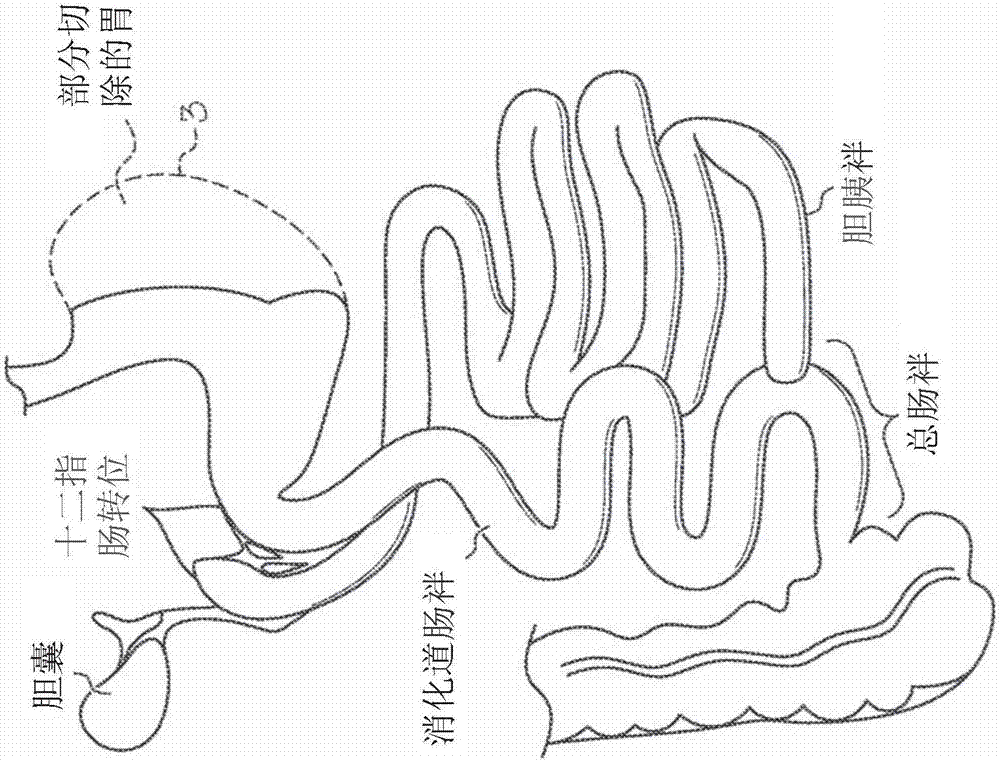Device allowing pyloric sphincter to normally function for bariatric stents
A technology of peace and prosthesis, applied in the field of devices for bariatric stents that allow the pyloric sphincter to function normally, and can solve problems such as short stents, unsuitable shapes for gastric geometry, and easy migration of stents
- Summary
- Abstract
- Description
- Claims
- Application Information
AI Technical Summary
Problems solved by technology
Method used
Image
Examples
Embodiment 1
[0115] Figure 5A A first embodiment of a prosthesis 10 with a single scaffold layer is shown. The prosthesis 10 has a stent 12 completely covered by a polymer covering 14 . The polymer covering 14 forms the outer surface of the prosthesis 10 . Such as Figure 5A The prosthesis 10 shown in may be implanted after a sleeve gastrectomy.
[0116] The stent 12 has a proximal stent flange 20 , a proximal stent segment 18 , an enlarged stent segment 16 , and a distal stent flange 24 . The proximal stent flange 20 defines the proximal end of the stent and the distal stent flange 24 defines the distal end of the stent 12 .
[0117] The proximal and distal stent flanges 20, 24 flare outwardly. The proximal end of the proximal stent flange 20 has a larger diameter than its distal end. The distal end of the distal stent flange 24 has a larger diameter than its proximal end.
[0118] The proximal stent flange 20, the proximal stent segment 18, and the enlarged stent segment 16 form ...
Embodiment 2
[0124] Figure 5B A second embodiment of a prosthesis 10 with a single scaffold layer is shown. The prosthesis 10 has a stent 12 completely covered by a polymer covering 14 . The polymer covering 14 forms the outer surface of the prosthesis 10 . Such as Figure 5B The prosthesis 10 shown in may be implanted after a sleeve gastrectomy.
[0125] The stent 12 has a proximal stent flange 20 , a proximal stent segment 18 , an enlarged stent segment 16 , and a distal stent flange 24 . The proximal stent flange 20 defines the proximal end of the stent and the distal stent flange 24 defines the distal end of the stent 12 .
[0126] The proximal and distal stent flanges 20, 24 flare outwardly. The proximal end of the proximal stent flange 20 has a larger diameter than its distal end. The distal end of the distal stent flange 24 has a larger diameter than its proximal end.
[0127] Proximal stent flange 20, proximal stent segment 18, and enlarged stent segment 16 form the proxima...
Embodiment 3
[0133] A third embodiment of a prosthesis 10 with a single scaffold layer is shown in Image 6 . The prosthesis 10 has a scaffold 12 and a polymeric covering 14 . The polymer covering 14 forms the outer surface of the prosthesis 10 . Such as Image 6 The prosthesis 10 shown in may be implanted after a sleeve gastrectomy.
[0134] The stent 12 has a proximal stent flange 20 , a proximal stent segment 18 , a large stent segment 16 , a braided link segment 22 and a distal stent flange 24 . Image 6 Braided link 22 is shown in a partially closed / contracted state.
[0135] The proximal and distal stent flanges 20, 24 are flared outward. The proximal end of the proximal stent flange 20 has a larger diameter than its distal end. The distal end of the distal stent flange 24 has a larger diameter than its proximal end.
[0136] Stent 12 has an overall longitudinal length of about 310 mm, and proximal stent flange 20 has a length of about 30 mm and a diameter of about 30 mm at it...
PUM
 Login to View More
Login to View More Abstract
Description
Claims
Application Information
 Login to View More
Login to View More - R&D
- Intellectual Property
- Life Sciences
- Materials
- Tech Scout
- Unparalleled Data Quality
- Higher Quality Content
- 60% Fewer Hallucinations
Browse by: Latest US Patents, China's latest patents, Technical Efficacy Thesaurus, Application Domain, Technology Topic, Popular Technical Reports.
© 2025 PatSnap. All rights reserved.Legal|Privacy policy|Modern Slavery Act Transparency Statement|Sitemap|About US| Contact US: help@patsnap.com



